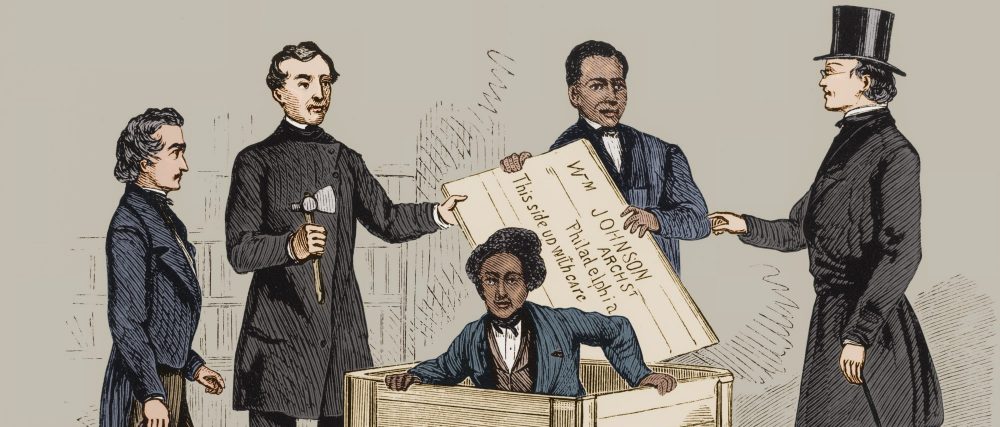In order to properly explain the relationship between slavery and the founding of Dickinson, I needed to provide context about slavery in Cumberland County during the college’s formative years. To do so, I turned to the Early American Newspapers database (Readex), made available via the Waidner Spahr library. Using the advanced search option, I entered “Negro” in on of the search bars (“Negro” is often used in place of “slave” in runaway advertisements) and set the place of publication as Carlisle. Most of the ensuing results were from the Carlisle Gazette, a paper established around 1785 that served as the town’s main organ during the period of Dickinson College’s founding.
Immediately, I found a record that tied Dickinson College even closer to slavery. It was a June 1787 notice placed by Trustee John Montgomery, one of the key figures in the college’s founding. He sought to sell a “strong, healthy Negro Wench, and a female Child six months old,” along with “two negro Boys, one about six and the other about four years old.” [1] Prospective buyers would have paid close attention to the ages of the enslaved children, knowing that those born after March 1, 1780, would eventually gain their freedom when they turned 28. Still, until then, the three children Montgomery had put up for sale could be sold legally within state lines and treated in the same way as those who were slaves for life.

Dickinson Trustee John Montgomery advertises four enslaved people for sale. (Carlisle Gazette, July 25, 1787, Readex Early American Newspapers Database)
Pennsylvania’s 1780 Gradual Abolition law, and the oftentimes muddied status of bondsmen in places like Cumberland County, led to considerable confusion. In late 1796, a man named James was arrested “on suspicion of being a Runaway” and housed in the Carlisle jail. “The negro says that he was not recorded,” read the notice, an indication that local African-Americans were using the Gradual Abolition law and its strict requirements on registration to their advantage. [2]
Beyond glimpses into local slavery, I had also hoped to find reference to the school for enslaved children founded around 1788, which I wrote about in a previous post. The school was intended to offer a Christian education for the children of “those people laboring under the unfortunate condition of slavery” in Carlisle and the surrounding region. [3] Remembering that one of the pledges on the school’s founding document, held in the Dickinson College Archives, came from the firm Kline and Reynolds (the printers of the Gazette), I speculated that they may have mentioned the school in their paper.
Modifying the search terms to “School,” with the place set as Carlisle and specifying the year as 1788, I found a specific mention to the school, which the editors of the Gazette referred to as the Charity School. It described a meeting of the subscribers, in which “it was agreed to set aside that part of the original plan, which respects the negroes.” This decision may reflect the second document contained in the Dickinson archives, where the school was shifted from a weekday school to an exclusively Sunday evening school, evidently geared more towards the poor white children than those of slaves. “It is hoped that many parents, unable to educate their children themselves,” read the notice in the Gazette, “will embrace this opportunity of obtaining the aid of the benevolent.” [4]

Notice of the founding of the Charity School. (Carlisle Gazette, November 28, 1787, Readex Early American Newspapers Database)
Now armed with a name, I added the term “Charity” to “School,” and removed the date restriction. With these new terms, I found what I had originally sought—a notice of the school’s founding. The Charity School began in November 1787, “intended for the purpose of instructing poor persons in reading, who are engaged during the week in the business of their employers or masters,” and was held initially on Sunday evenings at the Court House. During its inaugural session, 23 “scholars” were addressed by Dickinson College president Dr. Charles Nisbet, who encouraged them to “acquire a knowledge of the Holy Scriptures, imbue the precepts of the Savior of mankind, and converse as it were with his Holy Apostles[.]” [5] Using the same terms, I found yet another allusion to the Charity School in January 1789, announcing that the “subscribers” (those who had pledged money to sustain it) were to meet at Dickinson College, tying Dickinson even closer to the school. [6] What remains to be discerned is why the school’s subscribers (many of whom were Dickinson Trustees) decided to “set aside that part of the original plan, which respects the negroes,” and what that can tell us about the complicated relationship Dickinson’s founders had to slavery.
Notes
- “To be Sold,” Carlisle Gazette, July 25, 1787, Readex Early American Newspapers Database.
- “Committed,” Carlisle Gazette, February 15, 1797, Readex Early American Newspapers Database.
- List of Subscribers, c. 1788. O-Original-1788-1, Dickinson College Archives & Special Collections, Carlisle, Pa.
- Carlisle Gazette, June 4, 1788, Readex Early American Newspapers Database.
- Carlisle Gazette, November 28, 1787, Readex Early American Newspapers Database.
- Carlisle Gazette, January 7, 1789, Readex Early American Newspapers Database.
